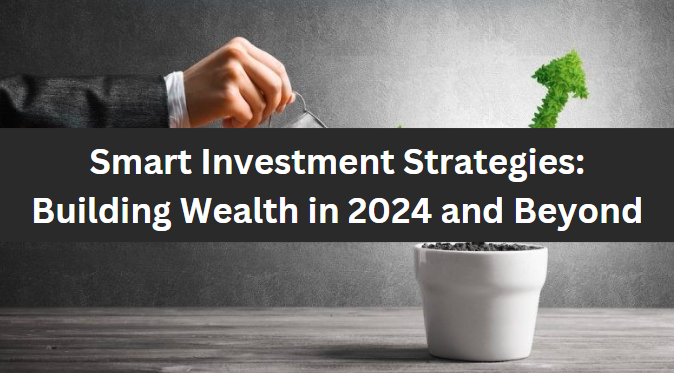Investing is a powerful tool for building wealth and securing your financial future. As we move through 2024 and look to the future, understanding smart investment strategies is crucial. This article will explore various investment options, tips for diversification, and ways to maximize returns while minimizing risks.
Contents
Understanding the Current Investment Landscape
Economic Outlook for 2024
The global economy in 2024 is marked by recovery and growth post-pandemic, but also by inflationary pressures and geopolitical uncertainties. Understanding these factors can help investors make informed decisions.
Key Trends Shaping Investments
- Technological Advancements: AI, blockchain, and other technologies continue to transform industries.
- Sustainability: ESG (Environmental, Social, Governance) investing is becoming more mainstream.
- Globalization and Geopolitics: Trade policies and international relations impact market stability and opportunities.
Diversifying Your Investment Portfolio
Diversification is a fundamental principle of investing. By spreading your investments across different asset classes, you can reduce risk and improve potential returns.
Asset Classes to Consider
- Stocks: Offers growth potential. Focus on sectors like technology, healthcare, and renewable energy.
- Bonds: Provides stability and income. Consider government and high-quality corporate bonds.
- Real Estate: A tangible asset that can provide rental income and appreciation.
- Commodities: Gold, silver, and oil can hedge against inflation.
- Cryptocurrencies: High risk but high reward. Diversify within this asset class too.
- Mutual Funds and ETFs: Offer diversification within a single investment.
Smart Investment Strategies for 2024
Long-Term Growth Strategies
- Invest in Index Funds: Low-cost and historically outperform actively managed funds.
- Focus on Quality Stocks: Companies with strong fundamentals, competitive advantages, and growth potential.
- Dividend Investing: Reinvest dividends for compounded growth.
Defensive Strategies
- Invest in Bonds and Fixed Income: To provide stability and preserve capital.
- Hold Cash Reserves: For emergencies and to capitalize on market dips.
Tactical Strategies
- Sector Rotation: Move investments between sectors based on economic cycles.
- Global Diversification: Invest in international markets to capture growth outside the US.
- Thematic Investing: Focus on emerging trends like green energy, AI, and biotech.
Managing Risk
Risk management is crucial to long-term investment success. Here are some strategies to manage and mitigate risks:
Regular Portfolio Rebalancing
Rebalancing your portfolio ensures you maintain your desired asset allocation, which helps manage risk and align with your investment goals.
Dollar-Cost Averaging
Investing a fixed amount regularly reduces the impact of market volatility and lowers the average cost of your investments.
Diversification
As mentioned earlier, diversification across different asset classes and geographic regions helps reduce overall risk.
Staying Informed
Keep abreast of economic indicators, market trends, and geopolitical developments that can impact your investments.
Leveraging Technology in Investment
Robo-Advisors
Robo-advisors use algorithms to provide investment advice and management. They offer low-cost, automated portfolio management and are a good option for hands-off investors.
AI and Big Data
Artificial Intelligence and Big Data are transforming investment strategies by analyzing vast amounts of data to identify trends, opportunities, and risks.
Investment Apps
Apps like Robinhood, Acorns, and E*TRADE make investing more accessible and allow for real-time trading, monitoring, and education.
Sustainable and Responsible Investing
ESG Investing
Investing in companies that prioritize environmental, social, and governance factors is not only ethical but also increasingly profitable as more consumers and investors demand sustainable practices.
Impact Investing
Invest in companies, organizations, and funds with the intention to generate social and environmental impact alongside a financial return.
Preparing for the Future
Setting Financial Goals
Define clear, achievable financial goals for short-term, medium-term, and long-term horizons. This will guide your investment strategy and help you stay focused.
Regular Review and Adjustment
Review your investment portfolio regularly to ensure it aligns with your goals and make adjustments as necessary based on performance and changing market conditions.
Educate Yourself
Continuous learning is key. Stay updated with investment news, read books, take courses, and consider consulting with a financial advisor.
Conclusion
Building wealth through smart investment strategies requires a combination of knowledge, planning, and discipline. By understanding the current investment landscape, diversifying your portfolio, managing risks, leveraging technology, and focusing on sustainable practices, you can set yourself up for financial success in 2024 and beyond. Remember, the key to successful investing is not just about making the right choices today, but also about adapting and evolving your strategies as the market changes.




